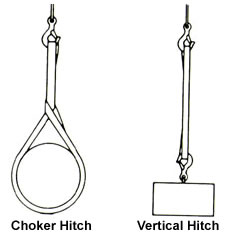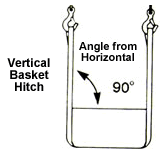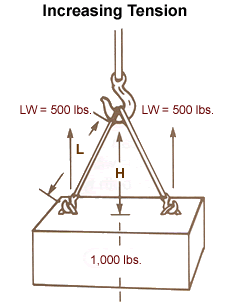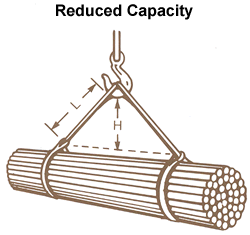Back to Product Page
|
|
|
Drum Handling Slings provide an easy, inexpensive way to handle
steel drums. Available in two styles to
suit your needs for handling drums in the vertical or horizontal
position. |
|
|
|
Vertical
Drum Handling Slings
|
|
 |
|
|
Easily
lift standing drums for transport. Tilt suspended
drums to pour from open top or spigot. For use with
ribbed steel drums, the ratcheting belly band tightens
securely below the first rib. |
|
|
|
Heavyweight
sling (DSV602D) uses 2" polyester sling
webbing and is rated at 850 lbs. |
|
|
|
| Promotes
Safety |
|
|
|
•
A wear pad, sewn on one side of the lifting strap, helps to
avoid cutting of the sling.
• Ratchet tightens securely. |
|
|
|
| Saves
Time |
|
|
|
•
Free end of ratchet strap sewn to stay properly threaded.
•Vertical
legs sewn to belly band to maintain proper position. |
|
|
|
To
Order, specify Part No. and drum diameter in inches. i.e.:
DSV602Dx24
(The standard 55 gal. drum has a 24" diameter.) |
|
|
|
|
|
 |
|
Horizontal
Drum Handling Slings
|
|
|
|
|
|
Ideal
for the quick and easy moving of steel drums
in the horizontal position. |
|
|
|
|
|
Part
No. DSH601D uses 1" polyester sling webbing
and is rated at 1,500 lbs. |
|
|
|
|
|
Promotes
Safety |
|
|
|
|
|
|
|
•
Strong 1" polyester webbing pulls drum hooks securely into
rims at both ends of the drum during lift. |
|
|
|
|
|
Saves
Time |
|
|
|
|
|
|
|
•
One sling fits multiple size drums.
• Easy to disconnect.
• Uses 1/2" oblong
link at top for easy connection to hoist hook. |
|
|
|
|
|
To
Order, specify Part No. DSH601D. |
|
|
|
|
|
Note:
If using in a chemical environment,
contact us for sling material advice. |
|
|
|
|
|
|
|
 |
|
Order
Online, by Phone, or by E-Mail |
|
|
|
~
Add items to your online shopping cart ~
Click a Price of the item you
wish to purchase.
|
|
|
|
|
PRICING
|
|
Drum Handling Slings Vertical - Standard Heavy Duty |
|
Model No. |
Web
Width (in.)
|
Drum
Dia. (in.)
|
Sling
Cap. (lbs.)
|
Price |
|
DSV602Dx24IN |
2
|
24
|
850
|
|
|
DSV602Dx30IN |
2
|
30
|
850
|
|
|
DSV602Dx36IN |
2
|
36
|
850
|
|
|
Drum Handling Sling Horizontal - Light Duty |
|
DSH601D |
1
|
24
|
300
|
$195.40 |
|
|
|
|
|
|
|
|
|
|
|
| EFFECT
OF SLING ANGLE |
|
|
|
|
|
|
|
|
|
Using
slings at an angle can become deadly if that angle is
not taken into consideration when selecting the sling to
be used. The tension on each leg of the sling is increased as
the angle of lift, from horizontal, decreases. It is most
desirable for a sling to have a larger angle of lift, approaching
90°. Lifts with angles of less than 30° from horizontal
are not recommended. If you can measure the angle of lift or
the length and height of the sling as rigged, you can
determine the properly rated sling for your lift. The Increased
Tension method provides the increased tension as a
function of the sling angle. Alternatively, the sling Reduced
Capacity method may be used to determine reduced lift
capacity for any angle. |
|
|
|
|
|
|
|
|
|
|
INCREASED
TENSION
Determine capacity
of sling needed
|
 |
REDUCED
CAPACITY
Calculate rating of each
sling
rigged at this angle
|
|
|
|
|
|
| 1.
Determine the load weight (LW). |
1.
Calculate the reduction factor (RF). |
|
|
|
|
a.
Using the angle from horizontal,
read across the Angle Chart to
the corresponding number of the
Reduction Factor column. |
| 2.
Calculate the Tension Factor [TF]. |
|
|
a.
Determine the sling angle as mea-
sured from the horizontal, and the
corresponding tension factor (TF)
from the effect of angle chart. |
|
|
|
-OR-
|
|
|
b.
Divide sling height* (H) by sling
length* (L). |
|
-OR-
|
|
|
|
b.
Length* (L) divided by height*
(H) |
|
|
|
|
|
2.
Reduction factor (RF) x the sling’s
rated capacity for the type hitch that
will be used = sling’s reduced rating. |
|
|
|
|
|
|
|
|
|
|
|
|
3.
Determine the share of the load
applied to each sling leg (LW). |
|
|
 |
|
|
|
|
|
|
|
|
|
|
|
|
|
|
4.
Multiply (LW) by (TF) to determine
the sling leg tension. The capacity of
the selected sling or sling leg must
meet the calculated tension value. |
|
|
*Measured
from a common horizontal
plane to the hoisting hook. |
|
|
|
|
|
|
|
|
|
|
|
|
*Measured
from a common horizontal plane
to the hoisting hook. |
|
|
|
|
|
|
|
|
|
|
|
|
|
|
|
|
 |
|
Effect
of Angle Chart
|
|
 |
|
|
Tension
Factor (TF) |
Angle From
Horizontal |
Reduction
Factor (RF) |
|
1.000 |
90º |
1.000 |
|
1.004 |
85º |
0.996 |
|
1.015 |
80º |
0.985 |
|
1.035 |
75º |
0.966 |
|
1.064 |
70º |
0.940 |
|
1.104 |
65º |
0.906 |
|
1.155 |
60º |
0.866 |
|
1.221 |
55º |
0.819 |
|
1.305 |
50º |
0.766 |
|
1.414 |
45º |
0.707 |
|
1.555 |
40º |
0.643 |
|
1.742 |
35º |
0.574 |
|
2.000 |
30º |
0.500 |
|
|
|
|
|
|
|
|
|
Example: |
|
|
|
Vertical
Choker rating of each sling:
6,000 lbs.
Measured Length (L) = 6 ft.
Measured Height (H) = 4 ft.
Reduction Factor (RF) = 4 (H) ÷ 6 (L) = .667 |
|
|
|
|
| Example: |
|
|
|
Load
weight = 1,000 lbs.
Rigging - 2 slings in vertical hitch
Lifting Weight (LW) per sling = 500 lbs.
Measured Length (L) = 10 ft.
Measured Height (H) = 5 ft.
Tension Factor (TF) = 10 (L) ÷ 5 (H) = 2.0
Minimum Vertical Rated Capacity required
for this lift = 500 (LW) x 2.0 (TF) = 1000 lbs.
per sling |
|
Sling
capacity decreases as the angle
from horizontal decreases. Sling angles
of less than 30° are not recommended. |
|
|
Reduced
sling rating in this configuration
= .667 |
|
(RF)
x 6,000 lbs. = 4,000 lbs. of lifting
capacity per sling |
|
|
|
|
|
|
|
Drum Handling
Sling, Webmaster 1600 Slings, Lifting Slings, Sling, Nylon
Slings, Lift-All, Nylon and Polyester Slings, Industrial Standard,
Drum Sling, Heavy Duty Sling, Synthetic Web Slings, Serial
Numbered Identification, Triangles and Chokers, Eye and
Eye Slings, Flat Eye, Twisted Eye, and Endless Slings from
your source for material handling equipment.
|
Back to Product Page
|


